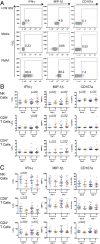Enhanced natural killer-cell and T-cell responses to influenza A virus during pregnancy
- PMID: 25246558
- PMCID: PMC4210016
- DOI: 10.1073/pnas.1416569111
Enhanced natural killer-cell and T-cell responses to influenza A virus during pregnancy
Abstract
Pregnant women experience increased morbidity and mortality after influenza infection, for reasons that are not understood. Although some data suggest that natural killer (NK)- and T-cell responses are suppressed during pregnancy, influenza-specific responses have not been previously evaluated. Thus, we analyzed the responses of women that were pregnant (n = 21) versus those that were not (n = 29) immediately before inactivated influenza vaccination (IIV), 7 d after vaccination, and 6 wk postpartum. Expression of CD107a (a marker of cytolysis) and production of IFN-γ and macrophage inflammatory protein (MIP) 1β were assessed by flow cytometry. Pregnant women had a significantly increased percentage of NK cells producing a MIP-1β response to pH1N1 virus compared with nonpregnant women pre-IIV [median, 6.66 vs. 0.90% (P = 0.0149)] and 7 d post-IIV [median, 11.23 vs. 2.81% (P = 0.004)], indicating a heightened chemokine response in pregnant women that was further enhanced by the vaccination. Pregnant women also exhibited significantly increased T-cell production of MIP-1β and polyfunctionality in NK and T cells to pH1N1 virus pre- and post-IIV. NK- and T-cell polyfunctionality was also enhanced in pregnant women in response to the H3N2 viral strain. In contrast, pregnant women had significantly reduced NK- and T-cell responses to phorbol 12-myristate 13-acetate and ionomycin. This type of stimulation led to the conclusion that NK- and T-cell responses during pregnancy are suppressed, but clearly this conclusion is not correct relative to the more biologically relevant assays described here. Robust cellular immune responses to influenza during pregnancy could drive pulmonary inflammation, explaining increased morbidity and mortality.
Conflict of interest statement
The authors declare no conflict of interest.
Figures




Similar articles
-
Elevated frequency of gamma interferon-producing NK cells in healthy adults vaccinated against influenza virus.Clin Vaccine Immunol. 2008 Jan;15(1):120-30. doi: 10.1128/CVI.00357-07. Epub 2007 Nov 14. Clin Vaccine Immunol. 2008. PMID: 18003818 Free PMC article.
-
Influenza Vaccination Primes Human Myeloid Cell Cytokine Secretion and NK Cell Function.J Immunol. 2019 Sep 15;203(6):1609-1618. doi: 10.4049/jimmunol.1801648. Epub 2019 Aug 19. J Immunol. 2019. PMID: 31427444 Free PMC article.
-
Expansion of 2B4+ natural killer (NK) cells and decrease in NKp46+ NK cells in response to influenza.Immunology. 2011 Apr;132(4):516-26. doi: 10.1111/j.1365-2567.2010.03394.x. Epub 2011 Jan 7. Immunology. 2011. PMID: 21214542 Free PMC article.
-
Heterogeneity of T Cell Responses to Pandemic pH1N1 Monovalent Vaccine in HIV-Infected Pregnant Women.AIDS Res Hum Retroviruses. 2015 Nov;31(11):1170-7. doi: 10.1089/aid.2015.0151. Epub 2015 Aug 31. AIDS Res Hum Retroviruses. 2015. PMID: 26322930 Free PMC article.
-
Priming with MF59 adjuvanted versus nonadjuvanted seasonal influenza vaccines in children - A systematic review and a meta-analysis.Vaccine. 2020 Jan 16;38(3):608-619. doi: 10.1016/j.vaccine.2019.10.053. Epub 2019 Nov 15. Vaccine. 2020. PMID: 31735505
Cited by
-
Maternal natural killer cells at the intersection between reproduction and mucosal immunity.Mucosal Immunol. 2021 Sep;14(5):991-1005. doi: 10.1038/s41385-020-00374-3. Epub 2021 Apr 26. Mucosal Immunol. 2021. PMID: 33903735 Free PMC article. Review.
-
Increased Proinflammatory Responses of Monocytes and Plasmacytoid Dendritic Cells to Influenza A Virus Infection During Pregnancy.J Infect Dis. 2016 Dec 1;214(11):1666-1671. doi: 10.1093/infdis/jiw448. Epub 2016 Sep 21. J Infect Dis. 2016. PMID: 27655870 Free PMC article.
-
Immunogenicity and Clinical Efficacy of Influenza Vaccination in Pregnancy.Front Immunol. 2015 Jun 4;6:289. doi: 10.3389/fimmu.2015.00289. eCollection 2015. Front Immunol. 2015. PMID: 26089824 Free PMC article. Review.
-
Pregnancy-Induced Alterations in NK Cell Phenotype and Function.Front Immunol. 2019 Oct 23;10:2469. doi: 10.3389/fimmu.2019.02469. eCollection 2019. Front Immunol. 2019. PMID: 31708922 Free PMC article.
-
Ebola virus protein VP40 stimulates IL-12- and IL-18-dependent activation of human natural killer cells.JCI Insight. 2022 Aug 22;7(16):e158902. doi: 10.1172/jci.insight.158902. JCI Insight. 2022. PMID: 35862204 Free PMC article.
References
-
- Mak TK, Mangtani P, Leese J, Watson JM, Pfeifer D. Influenza vaccination in pregnancy: Current evidence and selected national policies. Lancet Infect Dis. 2007;8(1):44–52. - PubMed
-
- Rasmussen SA, Jamieson DJ, Uyeki TM. Effects of influenza on pregnant women and infants. Am J Obstet Gynecol. 2012;207(Suppl 3):S3–S8. - PubMed
-
- Harris JW. Influenza occurring in pregnant women: A statistical study of thirteen hundred and fifty cases. J Am Med Assoc. 1919;72:978–980.
Publication types
MeSH terms
Substances
Grants and funding
LinkOut - more resources
Full Text Sources
Other Literature Sources
Medical

